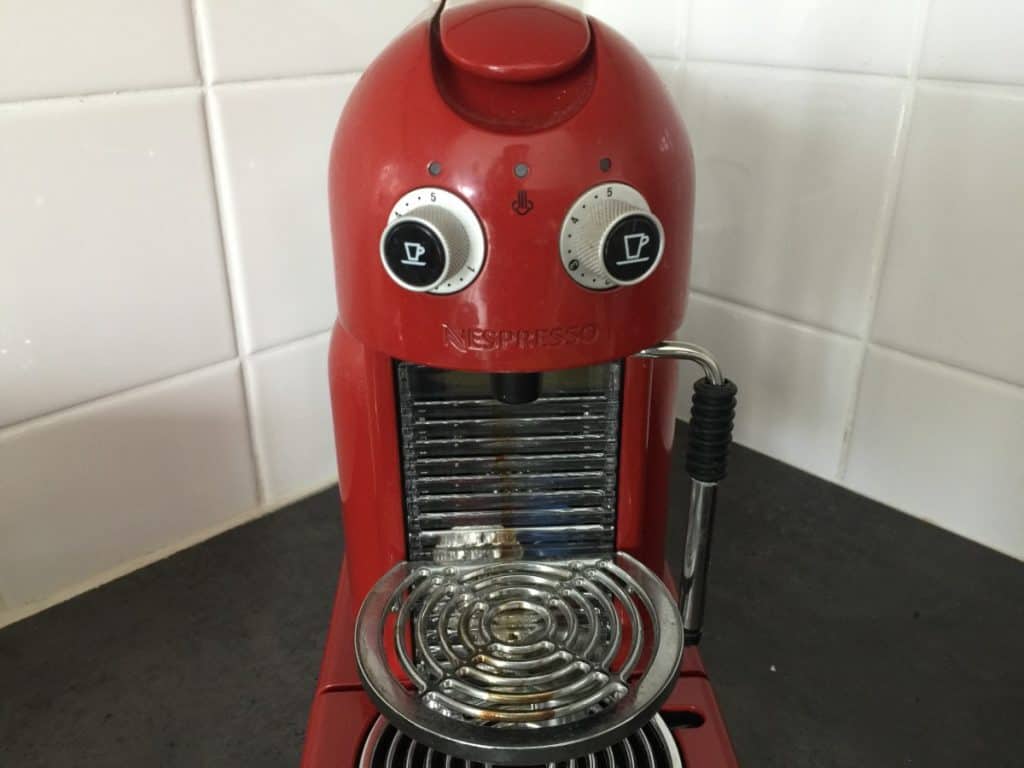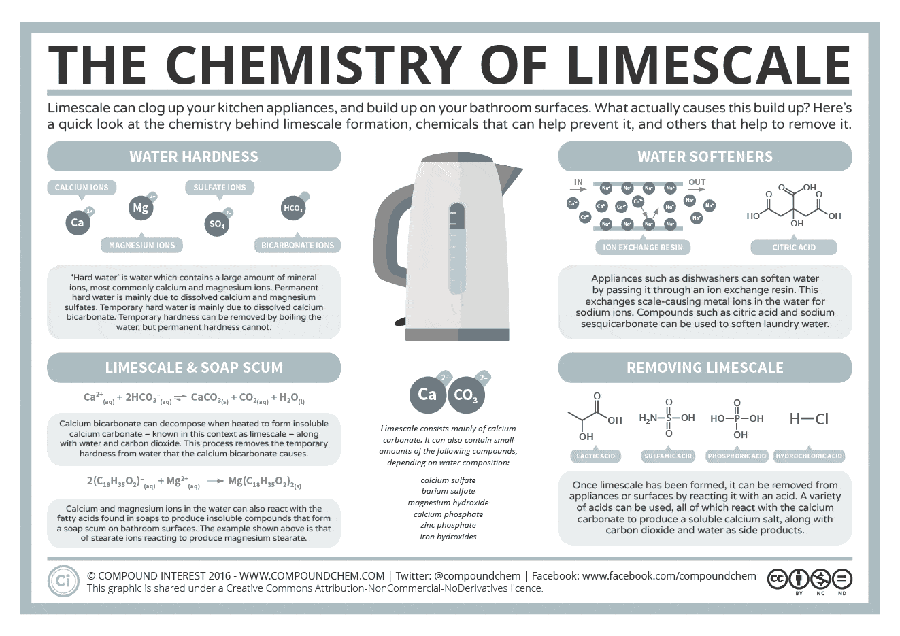
You know, it’s kind of funny: Most kitchen appliances get cleaned after they are used. Blender? Of course. Mixer? Right after the beaters have been licked clean. Not your coffee maker, though. Oftentimes, we wait until we notice a thick film on the surfaces or there is more steam billowing than water brewing before we even notice. At that point, it is obvious that something has to be done. Many times, it is just tolerated until the day the unit is replaced. Why is it that the one item in your kitchen, that you use EVERY SINGLE DAY, gets ignored until it is so bad that it can’t be ignored? Well, I’ll have to leave that question for wiser heads than mine, but a dirty coffee maker will not last as long as it is capable of and can even have implications to your health. And that is not even accounting for a lesser quality cup of coffee. Let’s face it, your coffee maker will need to be cleaned from time-to-time.
What Makes It Dirty
Your Water Reservoir
Limescale
Filter your water
Vinegar is Your Friend
How to sanitize your automatic brewing apparatus
Descale your coffee maker
How to clean a French press or cafetière
How to clean a cold brew setup
How to clean a pump espresso
How to clean a built-in grinder
Conclusion
What Makes It Dirty
Coffee’s most important taste components are contained in the oils present in the roasted beans. Over time, these oils, released in the brewing process, can build up on all the surfaces with which they come in contact. Coffee oils remaining on the brewing basket, drip spouts, and carafe can build up and eventually turn rancid. This will impart off-tastes to your brewed coffee and nobody wants that. A daily wipe down of the exterior of the machine and a wash in soapy water for the pot is the minimum amount of maintenance. It will go a long way toward keeping these oils at bay and will improve your morning cup. While the soapy water will take care of most of the oils and general build up, sometimes you will need to really get after it and clean the INSIDE of your coffee apparatus as well. Why? Well, there are a couple of reasons you should.
Your Water Reservoir
A 2011 study from NSF International found that about half of drip coffee makers – that’s a “Mr. Coffee” type brewer – had yeast and mold growing in their reservoirs. That’s the place that is holding the water you are about to be brewing with. Additionally, the average home coffee reservoir had a higher germ count than the average bathroom door handle or toilet seat. NO THANK YOU! Additionally, you can get a buildup of mineral deposits, also known as scale, on the inside of the unit. Let’s face it: brewed coffee is 98.75% water. If your water is nasty, your coffee will be nasty too.
Limescale
Those of us who boil our water in a kettle for our French press or pour overs have seen the white build up near the spout. If we look inside, we might see floating bits of sediment or large deposits of it on the heating element. For a real treat, next time you are staying in a hotel or B and B, check out the room’s kettle. That is limescale – scale for short. Most of us know that only distilled water should be used when we press our clothes. If we don’t, eventually the iron will “spit.” What does it spit? It spits little pieces of limescale.
What is Limescale
Limescale is primarily made up of calcium carbonate. Depending on the composition of your tap water it may also contain sulfates, phosphates, and hydroxides. When making steam, the minerals and compounds dissolved in our tap water are condensed. In an iron, they are then forced out by the steam to leave tiny stains on your previously nice white dress shirt. Using the same process, those minerals can build up inside your coffee maker.
Inside the reservoir (along with the mold, yeast, and bacteria) and inside the little plastic tubes that move the water through the heating element and into the brewing chamber, scale is constantly building. And that scale can affect many parts of the brewing cycle. Scale in the tubes restricts water flow, creating a great deal of steam. That steam was meant to be hot water to brew your coffee. Since it became steam and not hot water, your water to coffee ratio will be wrong and your brewing time will be longer. Regular readers know how I feel about my coffee to water ratio.
Limescale on the heating element can keep the unit from achieving the proper brewing temperature of 195ºF – 205ºF. Some chunks of that scale can make its way to the brewing basket. Sometimes the scale can prove to be such an obstacle in the tubes that it blocks the flow of hot water completely. Steam expands to 1700 times the volume of water. The pressure caused by the steam can rupture the water delivery system, essentially disabling your unit permanently. These types of units are not designed to be repaired. Nespresso and Keurig single-serve machines will often just turn off and cease to function.
Filter your water
The solution to this problem for coffee brewing is not the identical solution we use for our iron. Distilled water is “flat.” Some minerals in the brewing water are necessary for the coffee oils to properly extract and give you a good flavor. Additionally, some of the fancier Keurig machines do not work properly with distilled water. Commercially filtered drinking water is usually fine for this but that can get expensive after a while. That’s one of the reasons why I recommend that everyone filter their water before brewing with it. Even a simple Brita-type filtering system will improve the taste of your coffee by removing chlorine and it will leave some of the minerals behind for taste and proper brewing. But, every few months, and more often if you have particularly hard water, you will need to do a deep clean of your coffee brewing equipment. If your coffee maker is making a lot more steam and not as much coffee as it used to, it’s time to get to work.
Vinegar is Your Friend
While most automatic coffee makers, Keurig and Nespresso included, come with directions and web links to descaling kits and cleaning products that you can purchase from them, similar results can be achieved using good-old white vinegar. White vinegar, which is known in chemistry circles as acetic acid, will dissolve calcium carbonate.

How to sanitize your automatic brewing apparatus
First things first. Clean your brewer with dish soap and water. Clean the pot, wipe down the outside, and generally do a thorough job of getting into the nooks and crannies. Use a toothpick and toothbrush in the tight spots if you really want to get crazy. The more you remove, the better your end result. If your unit uses electricity, do not submerge it in water. Make sure you have removed all the soap before you go on to the next step.
Descale your coffee maker
Reassemble all the pieces-parts as if you were going to brew a pot of coffee or run a cycle on your single serve coffee machine. Fill your coffee pot or the reservoir on your unit with a mixture of half white vinegar and half water. Start to run it through your machine as you normally would but without coffee in the filter basket or a pod or capsule in the chamber. Stop the brewing process when it is halfway finished and let the vinegar sit for a minimum of 30 minutes. Feel free to let it sit longer, especially if you have a lot of buildup in your machine. What you are doing is giving the vinegar time to dissolve the built-up limescale that is on the inside of your coffee maker. Soak any removable pieces, such as steam wands and frothers in more of the half vinegar-half water solution. Use a toothbrush to loosen any stubborn deposits.
Restart your machine and let it finish the brewing cycle. Marvel at all the debris in the solution and discard it while congratulating yourself for doing such a good job.
You are not finished yet
Now comes the important part: Run clean water through the system normally. Repeat. Repeat a third time if you really want to be certain. You want to make sure all the vinegar is gone. Nothing is worse than vinegar coffee… not even decaf.
Now it is time to rewash everything: the pot, the filter basket, get back into those nooks and crannies. Use regular old dish soap and water and then rinse well. Now that you are an expert, if you see any remaining mineral buildup, use a little vinegar on a wash cloth to help dissolve it. You might as well wash your mug, too.
When you are finished, dry everything. Mold and bacteria love moist warm places and we don’t want them anywhere near our morning cup o’ joe.
How to clean a French press or cafetière
Cleaning your French Press is très simple. Dish soap and water is best for the carafe, with a half white vinegar – half water solution for any stubborn deposits. You might want to use a plastic scrubby or a toothbrush if the deposits are really tough. The internal parts of most presses unscrew from each other, which makes for easy cleaning. A good soaking in the vinegar solution will help here, too. Remember to use dish soap and water to get rid of the built-up coffee oils on all of the parts and to rinse everything thoroughly, so you don’t end up with sour coffee.
How to clean a cold brew setup
Cold brew setups mostly need straight forward cleaning with soap and water. For the longer tube parts, you need to watch out for buildup. Much like in an automatic brewer, a 50 / 50, white vinegar / water solution held inside the mechanism will allow time for the scale to dissolve. Wash well and rinse repeatedly before thoroughly drying all parts for storage.
How to clean a pump espresso
Much like the automatic machines, a pump espresso needs to be descaled so as to achieve the correct pressure for brewing. Use the 50 / 50, white vinegar / water solution to clean out the insides and follow that with a hand clean of all the removable parts. Remember, remove the oils so they don’t become rancid and ruin your coffee.
How to clean a built in grinder
If you have one of those expensive, fancy machines with a built-in grinder, congratulations! With a grinder, your two big enemies are the oils in the coffee beans and the dust and small particles created during the grinding process. As we have mentioned before, the oils can build up over time and become rancid, affecting the taste of your cup of coffee. The dust can get into all the nooks and crannies of the grinder, leading to decreased performance and over time, and may even cause the motor to fail.
Use a soft brush and a dry cloth to clean what you can on a regular basis. I recommend you give the grinder a little attention after each pound of coffee. If your grinder needs some “extra attention” you can purchase pellets specially designed to clean the mechanism of your grinder. If you aren’t worried about your warranty, you could do what I do with my antique hand grinder: I run a couple of tablespoons of instant rice through it. It accomplishes much the same thing and is softer than regular rice and so is safer for your grinder motor.
Conclusion
Cleaning your equipment is an important part of good brewing practice. The yeast, mold, and bacteria that can grow in the reservoir of your brewer is a health and flavor risk that is too easy to avoid. It also doesn’t take much effort to remove the oils and limescale that can build up in normal use. Remember to use vinegar and time to dissolve stubborn limescale deposits. Really remember to run water through your system a couple of times after using it. Sour coffee is no good. A little bit of work on your part can assure you of better coffee every morning.
What Makes It Dirty
Your Water Reservoir
Limescale
Filter your water
Vinegar is Your Friend
How to sanitize your automatic brewing apparatus
Descale your coffee maker
How to clean a French press or cafetière
How to clean a cold brew setup
How to clean a pump espresso
How to clean a built-in grinder
Conclusion
Be part of Procaffeination Nation!
Do you like coffee and fun? Join us in our Procaffeination Facebook Group. To be among the first to find out when the book is ready (and probably get a discount, too) sign up for the email list. No spam… I promise.

